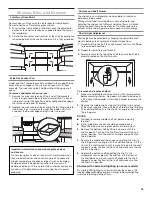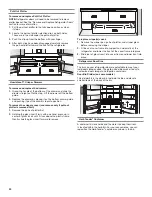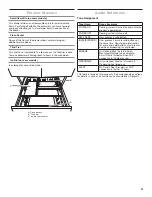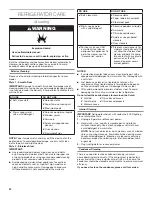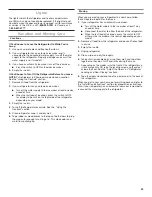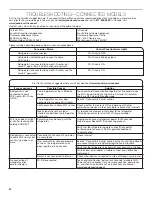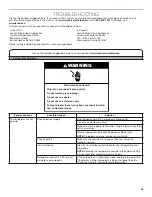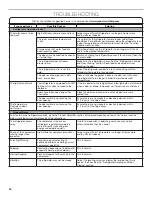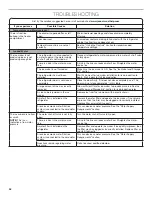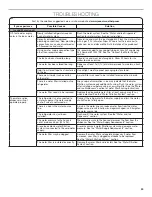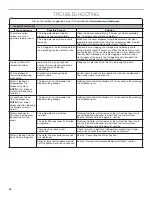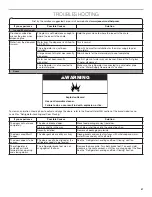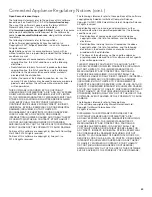
42
Connected Appliance Regulatory Notices
Federal Communications Commission
(FCC) Compliance Notice
This equipment has been tested and found to comply with the limits
for a Class B digital device, pursuant to Part 15 of the FCC Rules.
These limits are designed to provide reasonable protection against
harmful interference in a residential installation. This equipment
generates, uses, and can radiate radio frequency energy and, if not
installed and used in accordance with the instructions, may cause
harmful interference to radio communications. However, there is no
guarantee that interference will not occur in a particular installation.
If this equipment does cause harmful interference to radio or
television reception, which can be determined by turning the
equipment off and on, the user is encouraged to try to correct
the interference by one of the following measures:
– Reorient or relocate the receiving antenna.
– Increase the separation between the equipment and receiver.
– Connect the equipment into an outlet on a circuit different
from that to which the receiver is connected.
– Consult the dealer or an experienced radio/TV technician for help.
This device complies with Part 15 of the FCC Rules. Operation
is subject to the following two conditions:
1. This device may not cause harmful interference, and
2. This device must accept any interference received,
including interference that may cause undesired operation.
Changes or modifications not expressly approved by the party
responsible for compliance could void the user’s authority to
operate the equipment.
RF Exposure Information
To comply with FCC/IC RF exposure requirements for mobile
transmitting devices, this transmitter should only be used or
installed at locations where there is at least 20 cm separation
distance between the antenna and all persons.
To comply with FCC/IC RF exposure limits for general
population/uncontrolled exposure, the antenna(s) used for this
transmitter must be installed to provide a separation distance of
at least 20 cm from all persons and must not be co-located or
operating in conjunction with any other antenna or transmitter.
Industry Canada (IC) Compliance Notice
This Device complies with Industry Canada License-exempt RSS
standard(s). Operation is subject to the following two conditions:
1. This device may not cause interference,
2. This device must accept any interference, including
interference that may cause undesired operation of the device.
Under Industry Canada regulations, this radio transmitter may
only operate using an antenna of a type and maximum (or lesser)
gain approved for the transmitter by Industry Canada. To reduce
potential radio interference to other users, the antenna type and
its gain should be so chosen that the equivalent isotropically
radiated power (e.i.r.p.) is not more than that necessary for
successful communication.
This radio transmitter IC: 10248A-XPWG3 has been approved by
Industry Canada to operate with the antenna types listed below with
the maximum permissible gain and required antenna impedance for
each antenna type indicated. Antenna types not included in this list,
having a gain greater than the maximum gain indicated for that type,
are strictly prohibited for use with this device.
To comply with FCC and Industry Canada RF radiation
exposure limits for general population, the antenna(s) used for
this transmitter must be installed such that a minimum separation
distance of 20 cm is maintained between the radiator (antenna)
and all persons at all times and must not be co-located or
operating in conjunction with any other antenna or transmitter.
Antenna
Maximum Permissible
Required
Type
Antenna Gain (dBi)
Impedance (OHM)
Slot
1.76
50
OEM Responsibilities to comply with FCC
and Industry Canada Regulations
The XPWG3 Module has been certified for integration into
products only by OEM integrators under the following conditions:
1. The antenna(s) must be installed such that a minimum
separation distance of 20 cm is maintained between the
radiator (antenna) and all persons at all times.
2. The transmitter module must not be co-located or operating
in conjunction with any other antenna or transmitter.
As long as the two conditions above are met, further transmitter
testing will not be required. However, the OEM integrator is
still responsible for testing their end-product for any additional
compliance requirements required with this module installed (for
example, digital device emissions, PC peripheral requirements, etc.).
IMPORTANT NOTE:
In the event that these conditions cannot
be met (for certain configurations or co-location with another
transmitter), then the FCC and Industry Canada authorizations
are no longer considered valid and the FCC ID and IC
Certification Number cannot be used on the final product.
In these circumstances, the OEM integrator will be responsible
for re-evaluating the end product (including the transmitter) and
obtaining a separate FCC and Industry Canada authorization.
End Product Labeling
The XPWG3 Module is labeled with its own FCC ID and IC
Certification Number. If the FCC ID and IC Certification Number are
not visible when the module is installed inside another device, then
the outside of the device into which the module is installed must also
display a label referring to the enclosed module. In that case, the final
end product must be labeled in a visible area with the following:
“Contains Transmitter Module FCC ID: A5UXPWG3”
“Contains Transmitter Module IC: 10248A-XPWG3”
or
“Contains FCC ID: A5UXPWG3”
“Contains IC: 10248A-XPWG3”
The OEM of the XPWG3 Module must only use the approved
antenna(s), which have been certified with this module. The OEM
integrator has to be aware not to provide information to the end
user regarding how to install or remove this RF module or change
RF related parameters in the user manual of the end product.
The user manual for the end product must include
the following information in a prominent location:
“To comply with FCC and Industry Canada RF radiation
exposure limits for general population, the antenna(s) used for
this transmitter must be installed such that a minimum separation
distance of 20 cm is maintained between the radiator (antenna)
and all persons at all times and must not be co-located or
operating in conjunction with any other antenna or transmitter.”


